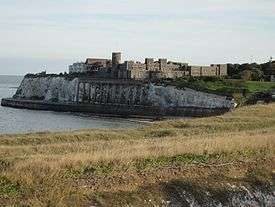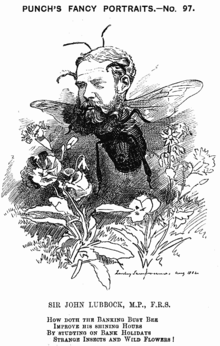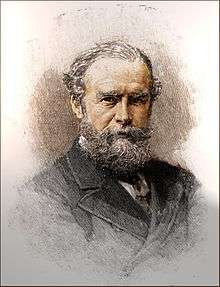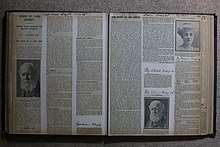John Lubbock, 1st Baron Avebury
John Lubbock, 1st Baron Avebury, 4th Baronet, PC, DL, FRS (30 April 1834 – 28 May 1913), known as Sir John Lubbock, 4th Baronet from 1865 until 1900, was an English banker, Liberal politician, philanthropist, scientist and polymath. Lubbock worked in his family company as a banker but made significant contributions in archaeology, ethnography, and several branches of biology. He coined the terms "Paleolithic" and "Neolithic" to denote the Old and New Stone Ages, respectively. He helped establish archaeology as a scientific discipline, and was also influential in nineteenth-century debates concerning evolutionary theory.[1] He introduced the first law for the protection of the UK's archaeological and architectural heritage. He was also a founding member of the X Club.
The Lord Avebury | |
|---|---|
 Woodburytype print of Lord Avebury in middle age | |
| Chairman of the London County Council | |
| In office 1892–1892 | |
| Preceded by | The Earl of Rosebery |
| Succeeded by | The Earl of Rosebery |
| Personal details | |
| Born | 30 April 1834 London, England |
| Died | 28 May 1913 (aged 79) Broadstairs, Kent, England |
| Nationality | English |
| Known for | Bank holidays & the Ancient Monuments Protection Act 1882 |
Early life
John Lubbock was born in 1834, the son of Sir John Lubbock, 3rd Baronet, a London banker, and was brought up in the family home of High Elms Estate, near Downe in Kent. The family had two homes, one at 29 Eaton Place, Belgrave Square where John was born and another in Mitcham Grove. Lubbock senior had studied mathematics at Cambridge University and had written on probability, and on astronomy. A Fellow of the Royal Society, he was keenly involved in the scientific debates of the time apart from serving as the Vice Chancellor of London University. During 1842, his father brought home a "great piece of news": the young Lubbock said later that he initially thought that the news might be of a new pony, and was disappointed to learn it was only that Charles Darwin was moving to Down House in the village.[2] The youth was soon a frequent visitor to Down House, and became the closest of Darwin's younger friends.[3] Their relationship stimulated young Lubbock's passion for science and evolutionary theory.[1] John's mother, Harriet, was deeply religious.
In 1845, Lubbock began studies at Eton College, and after graduation was employed by his father's bank (which later amalgamated with Coutts & Co), of which he became a partner at the age of twenty-two. Around 1852, he assisted Darwin's research by examining and illustrating barnacles. In 1865, he succeeded to the baronetcy.[4]
Business and politics
In the early 1870s, Lubbock became increasingly interested in politics. In 1870, and again in 1874, he was elected as a Liberal Party Member of Parliament (MP) for Maidstone. He lost the seat at the election of 1880, but was at once elected member for London University, of which he had been vice-chancellor since 1872.[4] As an MP, Lubbock had a distinguished political career, with four main political agendas: promotion of the study of science in primary and secondary schools; the national debt, free trade, and related economic issues; protection of ancient monuments; securing of additional holidays and shorter working hours for the working classes.[1] He was successful with numerous enactments in Parliament, including the Bank Holidays Act of 1871 and the Ancient Monuments Act of 1882, along with another 28 acts of Parliament. When the Liberals split in 1886 on the issue of Irish Home Rule, Lubbock joined the breakaway Liberal Unionist Party in opposition to Irish home rule. A prominent supporter of the Statistical Society, he took an active part in criticizing the encroachment of municipal trading and the increase of the municipal debt.[4]
Lubbock's thoughts about the nature and value of politics were deeply influenced by his scientific research, particularly his writings on early human society. He believed that the cognitive foundations of morality could be shaped through political economy, particularly through a national education system that implemented subjects mandated by the state. He held that the minds of children could be shaped in the direction of democracy, liberalism and morality through learning how to read and write. To this goal he was a strong supporter of the national education act of 1871 and he defended the introduction of the national curriculum during the 1870s and 1880s.[5]
In 1879, Lubbock was elected the first president of the Institute of Bankers. In 1881, he was president of the British Association, and from 1881 to 1886, president of the Linnean Society of London.[4] In March 1883, he founded the Bank Clerks Orphanage, which in 1986 became the Bankers’ Benevolent Fund – a charity for bank employees, past and present, and their dependants. In January 1884, he founded the Proportional Representation Society, later to become the Electoral Reform Society.


In recognition of his contributions to the sciences, Lubbock received honorary degrees from the universities of Oxford, Cambridge (where he was Rede lecturer in 1886), Edinburgh, Dublin and Würzburg; and was appointed a trustee of the British Museum in 1878. He received the German Order Pour le Mérite for Science and Arts in August 1902.[6]
From 1888 to 1892, he was president of the London Chamber of Commerce, and he was later President of the Association of Chambers of Commerce of the United Kingdom. In local politicas, he was from 1889 to 1890 vice-chairman and from 1890 to 1892 chairman of the London County Council.[4] In February 1890 he was appointed a privy councillor;[7] and was chairman of the committee of design for the new coinage in 1891. On 22 January 1900, he was raised to the peerage as Baron Avebury, of Avebury, in the county of Wiltshire,[8] his title commemorating the largest Stone Age site in Britain, which he had helped to preserve. (He had purchased it in 1871 when the site was threatened with destruction.) He was President of the Royal Statistical Society from 1900 to 1902.[9]
In November, 1905, Lord Avebury, together with Lord Courtney of Penwith, founded an Anglo-German Friendship Committee which sought to counteract the influence of the British war party, whose anti-German propaganda was then at its zenith, and smooth the way towards more amicable relations between England and Germany.
The quotation, "We may sit in our library and yet be in all quarters of the earth", is often attributed to Lubbock. This variation appears in his book The Pleasures of Life.
Archaeology and biological science

In addition to his work at his father's bank, Lubbock took a keen interest in archaeology and evolutionary theory. In 1855, he and Charles Kingsley discovered the skull of a musk ox in a gravel pit, a discovery that was commended by Darwin.[10] A collection of Iron Age antiquities Lubbock and Sir John Evans excavated at the site of Hallstatt in Austria is now in the British Museum's collection.[11][12] He spoke in support of the evolutionist Thomas Henry Huxley at the famous 1860 Oxford evolution debate. During the 1860s, he published many articles in which he used archaeological evidence to support Darwin's theory.[1] In 1864, he became one of the founding members (along with Thomas Henry Huxley and others) of the elite X Club, a dining club composed of nine gentlemen to promote the theories of natural selection and academic liberalism. During the 1860s he held a number of influential academic positions, including President of the Ethnological Society from 1864–65, Vice-President of Linnean Society in 1865, and President of the International Congress of Prehistoric Archaeology in 1868. In 1865 he published Pre-Historic Times, which became a standard archaeology textbook for the remainder of the century, with the seventh and final edition published in 1913.[1]
His second book, On the Origin of Civilization, was published in 1870. During 1871, he purchased part of the Avebury estate to protect its prehistoric stone monuments from impending destruction. During the early 1870s, he held the position of President of the Anthropological Institute of Great Britain and Ireland from 1871–72,[13] as well as the position of Vice President of the Royal Society in 1871. During this period he worked with John Evans, the other key figure in the establishment of the discipline of archaeology.[1]
In 1865, Lubbock published what was possibly the most influential archaeological text book of the nineteenth century, Pre-historic times, as illustrated by ancient remains, and the manners and customs of modern savages. He invented the terms "Palaeolithic" and "Neolithic" to denote the Old and New Stone Ages, respectively.[14] He also introduced a Darwinian-type theory of human nature and development. "What was new was Lubbock’s ... insistence that, as a result of natural selection, human groups had become different from each other, not only culturally, but also in their biological capacities to utilize culture." [15]
Lubbock complained in the preface to Pre-Historic Times about Charles Lyell:
- "Note.—In his celebrated work on the Antiquity of Man, he coined the term Neolithic in 1865. Sir Charles Lyell has made much use of my earlier articles in the Natural History Review, frequently, indeed, extracting whole sentences verbatim, or nearly so. But as he has in these cases omitted to mention the source from which his quotations were derived, my readers might naturally think that I had taken very unjustifiable liberties with the work of the eminent geologist. A reference to the respective dates will, however, protect me from any such inference. The statement made by Sir Charles Lyell, in a note to page 11 of his work, that my article on the Danish Shell-mounds was published after his sheets were written, is an inadvertence, regretted, I have reason to believe, as much by its author as it is by me."[16]
 Pages from a book of obituary cuttings following the death of Sir John Lubbock in 1913.
Pages from a book of obituary cuttings following the death of Sir John Lubbock in 1913.
In 1871, he bought land at Avebury to prevent part of the ancient stone circle from being built on. This, and other threats to the nation's heritage, persuaded him that some legal protection was needed. In 1874, he introduced a parliamentary bill that would identify a list of ancient sites that deserved legal protection. After several later attempts and against some opposition, it was not until 1882 that a much watered down version, The Ancient Monuments Act, came into being. Though restricted to 68 largely prehistoric monuments it was the forerunner of all later laws governing the UK's archaeological and architectural heritage.[17]
Lubbock was also an amateur biologist of some distinction, writing books on hymenoptera (Ants, Bees and Wasps: a record of observations on the habits of the social hymenoptera. Kegan Paul, London; New York: Appleton, 1884), on insect sense organs and development, on the intelligence of animals, the first monograph on UK Collembola (Monograph on the Collembola and Thysanura, Ray Society, London), and on other natural history topics. He discovered that ants were sensitive to light in the near ultraviolet range of the electromagnetic spectrum.[18][19] The following verse from Punch of 1882 captured him perfectly:

- How doth the Banking Busy Bee,
- Improve his shining Hours?
- By studying on Bank Holidays,
- Strange insects and Wild Flowers!
He corresponded extensively with Charles Darwin, who lived nearby in Down House.[20] Lubbock stayed in Downe except for a brief period from 1861–65, when he lived in Chislehurst. Both men were active advocates of English spelling reform, and members of the Spelling reform Association, precursor to the Simplified Spelling Society. Darwin rented land, originally from Lubbock's father, for the Sandwalk wood where he performed his daily exercise, and in 1874 agreed with Lubbock to exchange the land for a piece of pasture in Darwin's property.[21] When Darwin died in 1882, Lubbock suggested the honour of burial in Westminster Abbey, organising a letter to the dean to arrange this, and was one of the pallbearers.[3]
In 1893, Lubbock was elected a member of the American Antiquarian Society.[22]
Family
Lubbock was one of eight brothers and three sisters;[23] three brothers, Alfred,[24] Nevile[25] and Edgar,[26] played first-class cricket for Kent. Edgar and Alfred also played football and played together for Old Etonians in the 1875 FA Cup Final. His nephew was Percy Lubbock, a prominent man of letters.
Lubbock married Ellen Frances Horden in April 1856. Five years after her death in 1879, he married Alice Lane Fox, the daughter of Augustus Pitt Rivers on 17 May 1884.[27] He rebuilt Kingsgate Castle, near Broadstairs in Kent, as his family home, where he died in 1913.
He was succeeded by his eldest son, John.
References
- Mithen, Steven (2006). After the Ice: A Global Human History, 20,000-5000 BC. Agricultural History. 80. Cambridge, MA: Harvard University Press. pp. 376–378. doi:10.1086/513401. ISBN 978-0-674-01570-8. JSTOR 3744830.
- Howarth & Howarth 1933, pp. 72–73
- Freeman 1978, p. 192
-

- Eddy, Matthew Daniel (2017). "The politics of cognition: liberalism and the evolutionary origins of Victorian education". British Journal for the History of Science. 50 (4): 677–699. doi:10.1017/S0007087417000863. PMID 29019300.
- "Court Circular". The Times (36850). London. 19 August 1902. p. 8.
- London Gazette issue 26022 11 February 1890 Archived 29 September 2008 at the Wayback Machine
- "No. 27156". The London Gazette. 23 January 1900. p. 427.
- "Royal Statistical Society Presidents". Royal Statistical Society. Archived from the original on 17 March 2012. Retrieved 6 August 2010.
- Clark, J. F. M. (20 March 2014). "The science of John Lubbock". Notes Rec. R. Soc. 68 (1): 3–6. doi:10.1098/rsnr.2013.0069. ISSN 0035-9149. PMC 3928876.
- British Museum Collection
- British Museum Collection
- "Presidents". Royal Anthropological Institute. Retrieved 9 February 2018.
- Pettitt, Paul; White, Mark (20 March 2014). "John Lubbock, caves, and the development of Middle and Upper Palaeolithic archaeology". Notes and Records. 68 (1): 35–48. doi:10.1098/rsnr.2013.0050. ISSN 0035-9149. PMC 3928871.
- Trigger, Bruce G. (1989) A History of Archaeological Thought, Cambridge, p.173
- Lubbock J. (1865) Pre-Historic Times, Williams & Norgate, London
- Thurley, Simon."The Men from the Ministry", Yale University Press. 2013. ISBN 978-0-300-19572-9
- Lubbock, J. (1881). "Observations on ants, bees, and wasps. IX. Color of flowers as an attraction to bees: Experiments and considerations thereon". J. Linn. Soc. Lond. (Zool.). 16 (90): 110–112. doi:10.1111/j.1096-3642.1882.tb02275.x.CS1 maint: ref=harv (link)
- Kevan, Peter G.; Chittka, Lars; Dyer, Adrian G. (2001). "Limits to the Salience of Ultraviolet: Lessons from Colour Vision in Bees and Birds". J. Exp. Biol. 204 (14): 2571–2580. PMID 11511673.CS1 maint: ref=harv (link)
- "Darwin Correspondence Project", John Lubbock, 1834–1913". Retrieved 28 May 2012.
- Freeman 1978, p. 125
- American Antiquarian Society Members Directory
- "Sir John William Lubbock, 3rd Bt". The Peerage.com. 29 January 2011. Retrieved 9 February 2011.
- "Alfred Lubbock". Cricket Archive. Retrieved 10 February 2011.
- "Nevile Lubbock". Cricket Archive. Retrieved 10 February 2011.
- "Edgar Lubbock". Cricket Archive. Retrieved 10 February 2011.
- "The marriage of Sir John Lubbock ...". The Cornishman (304). 15 May 1884. p. 6.
- Howarth, O. J. R.; Howarth, E. K. (1933), A history of Darwin's parish: Downe, Kent. With a foreword by Sir Arthur Keith, Southampton: Russell & Co.
Books
The following is a list of publications by Sir John Lubbock, arranged in chronological order by the dates of the first editions of each work.
- Lubbock J. (1865) Pre-Historic Times, As Illustrated by Ancient Remains, and the Manners and Customs of Modern Savages, Williams & Norgate, London
- Lubbock J. (1870) The Origin of Civilisation and the Primitive Condition of Man, Longmans, Green & Co., London
- Lubbock J. (1871) Monograph on the Collembola and Thysanura, Ray Society, London
- Lubbock J. (1872) On the Origin and the Metamorphoses of Insects, Macmillan & Co., London
- Lubbock J. (1873) British Wild Flowers Considered in relation to Insects, Macmillan & Co., London
- Lubbock J. (1874) Scientific Lectures, Macmillan & Co., London
- Lubbock J. (1879) Addresses, Political and Educational, Macmillan & Co., London
- Lubbock J. (1881) Fifty Years of Science, Being the Address Delivered at York to the British Association, August 1881, Macmillan & Co., London
- Lubbock J. (1882) Ants, Bees and Wasps: A Record of Observations on the Habits of the Social Hymenoptera, Keegan Paul, Trench, Trübner, & Co. Ltd., London: 442 pp.
- Lubbock J. (1882) Chapters in Popular Natural History, National Society, London
- Lubbock J. (1883) On Representation, Swan Sonnenschein & Co., Berne
- Lubbock J. (1882) Flowers, Fruits and Leaves, Macmillan & Co., London
- Lubbock J. (1883) On the Senses, Instincts and Intelligence of Animals, With Special Reference to Insects, Keegan Paul, Trench, Trübner, & Co. Ltd., London: 512 pp.
- Lubbock J. (1887–89) The pleasures of life, (2 volumes) Macmillan & Co., London
- Lubbock J. (1889) La Vie des Plantes, Hachette Livre
- Lubbock J. (1890) Flowers and Insects, Macmillan & Co., London (Included in later compilations)
- Lubbock J. (1892) The Beauties of Nature, Macmillan & Co., London
- Lubbock J. (1894) The Use of Life, Macmillan & Co., London
- Lubbock J. (1896) The Scenery of Switzerland, Macmillan & Co., London
- Lubbock J. (1898) On Buds and Stipules, Keegan Paul, Trench, Trübner, & Co. Ltd., London: 239 pp.
- Lubbock J. (1902) The Scenery of England, Macmillan & Co., London
- Lubbock J. (1902) A Short History of Coins and Currency, John Murray
- Lubbock J. (1904) Free Trade, Macmillan & Co., London
- Lubbock J. (1905) Notes on The Life History of British Flowering Plants, Macmillan & Co., London
- Lubbock J. (1905) Happiness and Thrift, Macmillan & Co., London
- Lubbock J. (1906) On Municipal and National Trading, Macmillan & Co., London
- Lubbock J. (1909) On Peace and Happiness, Macmillan & Co., London
- Lubbock J. (1911) Marriage, Totemism and Religion, Longmans, Green & Co., London
Further reading
- Freeman, R.B. (1978). "Charles Darwin: A companion". Folkestone: William Dawson & Sons Ltd. Cite journal requires
|journal=(help)CS1 maint: ref=harv (link) - Grant Duff U. (1924) The life-work of Lord Avebury, Watts & Co., London.
- Hutchinson H.G. (1914) Life of Sir John Lubbock, Lord Avebury, London. Volume 1. 2
- Parsons, F.D. (2009) 'Thomas Hare and Political Representation in Victorian Britain' (Palgrave Macmillan)
- Patton M. (2007) Science, politics & business in the work of Sir John Lubbock – a man of universal mind, Ashgate, London.
- Pearn, Alison (2014) "The teacher taught? What Charles Darwin owed to John Lubbock". Notes Rec R Soc Lond. Mar 20; 68(1): 7–19.
- Sir John Lubbock in The Columbia Encyclopedia, (Sixth Edition, 2001)
- Trigger B.G. (1989) A history of archaeological thought, (revised 2006) Cambridge University Press, Cambridge.
- Kains-Jackson, C.P (1880) " Our Ancient Monuments and the Land Around them, with a preface by Sir John Lubbock", Elliot Stock, London.
External links
| Wikiquote has quotations related to: John Lubbock, 1st Baron Avebury |

- Works by John Lubbock, 1st Baron Avebury at Project Gutenberg
- Portraits of John Lubbock, 1st Baron Avebury at the National Portrait Gallery, London

- Works by or about John Lubbock, 1st Baron Avebury at Internet Archive
- Hansard 1803–2005: contributions in Parliament by John Lubbock
- "John Lubbock— forgotten polymath", by Phillip Steadman, New Scientist, 10 January 1980, p84
- Obituary
- Electoral Reform Society
- Lubbock J. (1865) Pre-historic times,
- Lubbock J. (1871) Monograph of the Collembola and Thysanura, Ray Society, London
- Lubbock J. (1879) Addresses, Political and Educational, Macmillan & Co., London
- John Lubbock at Minnesota State University eMuseum
- John Lubbock at bartleby.com
- "History of High Elms Golf Club and Course". Archived from the original on 17 May 2012. Retrieved 18 October 2009.
- portrait
- Cricket career on Cricket Archive
| Parliament of the United Kingdom | ||
|---|---|---|
| Preceded by Charles Buxton James Whatman |
Member of Parliament for Maidstone 1870–1880 With: James Whatman 1865–1874 Sir Sydney Waterlow 1874–1880 |
Succeeded by Alexander Henry Ross John Evans Freke-Aylmer |
| Preceded by Robert Lowe |
Member of Parliament for London University 1880–1900 |
Succeeded by Sir Michael Foster |
| Political offices | ||
| Preceded by The Earl of Rosebery |
Chairman of the London County Council 1890–1892 |
Succeeded by The Earl of Rosebery |
| Academic offices | ||
| Preceded by George Grote |
Vice-Chancellor of University of London 1872–1880 |
Succeeded by Sir George Jessel |
| Preceded by Andrew Carnegie |
Rector of the University of St Andrews 1907–1910 |
Succeeded by The Earl of Rosebery |
| Peerage of the United Kingdom | ||
| New creation | Baron Avebury 1900–1913 |
Succeeded by John Lubbock |
| Baronetage of the United Kingdom | ||
| Preceded by John Lubbock |
Baronet (of Lammas) 1865–1913 |
Succeeded by John Lubbock |